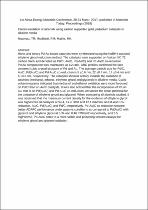 ResearchSpace
ResearchSpace
Electro-oxidation of alcohols using carbon supported gold, palladium catalysts in alkaline media
JavaScript is disabled for your browser. Some features of this site may not work without it.
- ResearchSpace
- →
- Research Publications/Outputs
- →
- Conference Publications
- →
- View Item
| dc.contributor.author |
Maumau, Thandiwe R

|
|
| dc.contributor.author |
Modibedi, Remegia M

|
|
| dc.contributor.author |
Mathe, Mahlanyane K

|
|
| dc.date.accessioned | 2019-03-11T06:41:20Z | |
| dc.date.available | 2019-03-11T06:41:20Z | |
| dc.date.issued | 2018-05 | |
| dc.identifier.citation | Maumau, T.R., Modibedi, R.R., Mathe, M.K., 2018. Electro-oxidation of alcohols using carbon supported gold, palladium catalysts in alkaline media. 1st Africa Energy Materials Conference, 28-31 March 2017, published in Materials Today: Proceedings (2018), pp 10542-10550. | en_US |
| dc.identifier.uri | https://www.sciencedirect.com/science/article/pii/S2214785317333928 | |
| dc.identifier.uri | http://hdl.handle.net/10204/10778 | |
| dc.description | Copyright: 2018 Elsevier. Due to copyright restrictions, the attached PDF file only contains the abstract of the full text item. For access to the full text item, kindly consult the publisher's website | en_US |
| dc.description.abstract | Mono and binary Pd-Au based catalysts were synthesized using the NaBH4 assisted ethylene glycol reduction method. The catalysts were supported on Vulcan XC 72 carbon black and denoted as Pd/C, Au/C, Pd(Au/C) and Pd-Au/C co-reduction. Pd:Au composition was maintained at 1:2 ratio. XRD profiles confirmed the face centered cubic crystal structure of Pd and Au. The average particle size for Pd/C, Au/C, Pd(Au/C) and Pd-Au/C co-reduction is 5 ±0.6 nm, 22 ±0.7 nm, 17 ±0.4 nm and 6 ±0.2 nm, respectively. The catalysts showed activity towards the oxidation of alcohols (methanol, ethanol, ethylene glycol and glycerol) in alkaline media. Cyclic voltammograms indicated that methanol and ethanol oxidation were more favoured on Pd/C than on Au/C catalysts. It was also noticed that the incorporation of Pd on Au, that is on Pd(Au/C) and Pd-Au/C co-reduction, enhances the onset potential for the oxidation of ethylene glycol and glycerol. When comparing all alcohols studied, it was observed that the maximum current density for the oxidation of ethylene glycol was highest for all catalysts at 54.4, 41.4, 39.8 and 12.1 mA/cm2 on Pd-Au/C co-reduction, Au/C, Pd(Au/C) and Pd/C, respectively. Pd-Au/C co-reduction showed better ADAFC performance under passive conditions as compared to Pd(Au/C) with glycerol and ethylene glycol at 8.34 and 8.46 mW/cm2 respectively, and 0.5 mgPd/cm2. Pd-Au/C cored is a more stable and poisoning tolerant catalyst for ethylene glycol and glycerol oxidation. | en_US |
| dc.language.iso | en | en_US |
| dc.relation.ispartofseries | Worklist;21536 | |
| dc.subject | Palladium | en_US |
| dc.subject | Gold | en_US |
| dc.subject | Alkaline fuel cell | en_US |
| dc.subject | Alcohol oxidation | en_US |
| dc.subject | Stability | en_US |
| dc.title | Electro-oxidation of alcohols using carbon supported gold, palladium catalysts in alkaline media | en_US |
| dc.type | Conference Presentation | en_US |
| dc.identifier.apacitation | Maumau, T. R., Modibedi, R. M., & Mathe, M. K. (2018). Electro-oxidation of alcohols using carbon supported gold, palladium catalysts in alkaline media. http://hdl.handle.net/10204/10778 | en_ZA |
| dc.identifier.chicagocitation | Maumau, Thandiwe R, Remegia M Modibedi, and Mahlanyane K Mathe. "Electro-oxidation of alcohols using carbon supported gold, palladium catalysts in alkaline media." (2018): http://hdl.handle.net/10204/10778 | en_ZA |
| dc.identifier.vancouvercitation | Maumau TR, Modibedi RM, Mathe MK, Electro-oxidation of alcohols using carbon supported gold, palladium catalysts in alkaline media; 2018. http://hdl.handle.net/10204/10778 . | en_ZA |
| dc.identifier.ris | TY - Conference Presentation AU - Maumau, Thandiwe R AU - Modibedi, Remegia M AU - Mathe, Mahlanyane K AB - Mono and binary Pd-Au based catalysts were synthesized using the NaBH4 assisted ethylene glycol reduction method. The catalysts were supported on Vulcan XC 72 carbon black and denoted as Pd/C, Au/C, Pd(Au/C) and Pd-Au/C co-reduction. Pd:Au composition was maintained at 1:2 ratio. XRD profiles confirmed the face centered cubic crystal structure of Pd and Au. The average particle size for Pd/C, Au/C, Pd(Au/C) and Pd-Au/C co-reduction is 5 ±0.6 nm, 22 ±0.7 nm, 17 ±0.4 nm and 6 ±0.2 nm, respectively. The catalysts showed activity towards the oxidation of alcohols (methanol, ethanol, ethylene glycol and glycerol) in alkaline media. Cyclic voltammograms indicated that methanol and ethanol oxidation were more favoured on Pd/C than on Au/C catalysts. It was also noticed that the incorporation of Pd on Au, that is on Pd(Au/C) and Pd-Au/C co-reduction, enhances the onset potential for the oxidation of ethylene glycol and glycerol. When comparing all alcohols studied, it was observed that the maximum current density for the oxidation of ethylene glycol was highest for all catalysts at 54.4, 41.4, 39.8 and 12.1 mA/cm2 on Pd-Au/C co-reduction, Au/C, Pd(Au/C) and Pd/C, respectively. Pd-Au/C co-reduction showed better ADAFC performance under passive conditions as compared to Pd(Au/C) with glycerol and ethylene glycol at 8.34 and 8.46 mW/cm2 respectively, and 0.5 mgPd/cm2. Pd-Au/C cored is a more stable and poisoning tolerant catalyst for ethylene glycol and glycerol oxidation. DA - 2018-05 DB - ResearchSpace DP - CSIR KW - Palladium KW - Gold KW - Alkaline fuel cell KW - Alcohol oxidation KW - Stability LK - https://researchspace.csir.co.za PY - 2018 T1 - Electro-oxidation of alcohols using carbon supported gold, palladium catalysts in alkaline media TI - Electro-oxidation of alcohols using carbon supported gold, palladium catalysts in alkaline media UR - http://hdl.handle.net/10204/10778 ER - | en_ZA |





